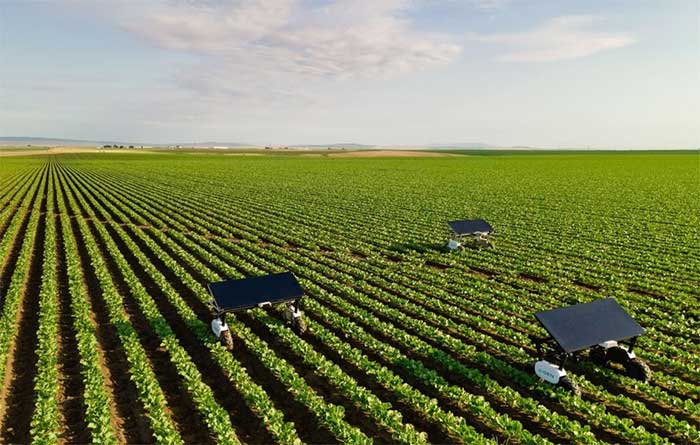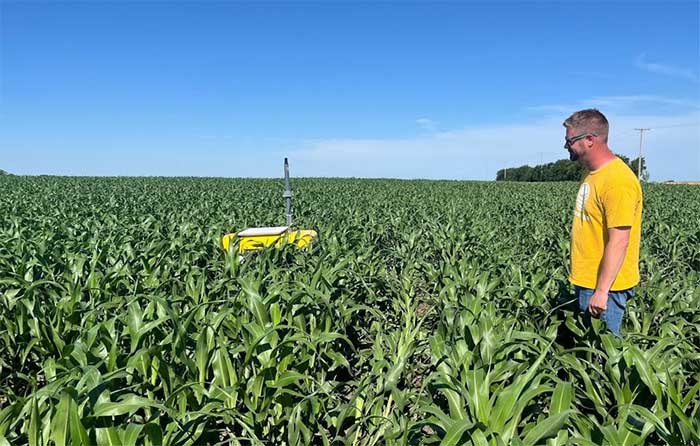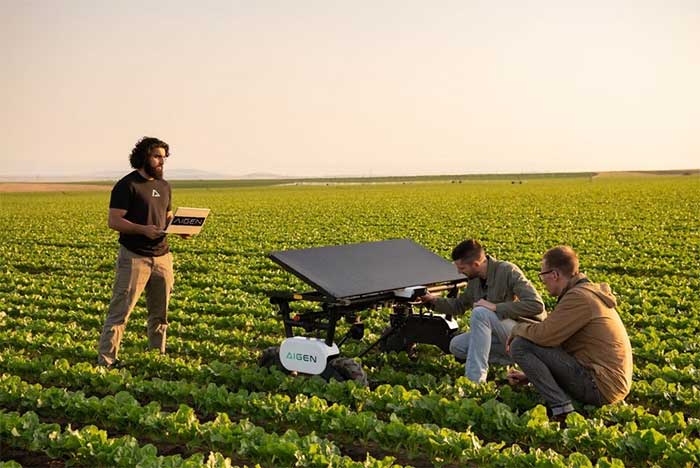On a sweltering summer day in Central Kansas, USA, farmer Clint Brauer observed a fleet of yellow robots tirelessly moving up and down rows, meticulously trimming any weeds in their path. These robots even actively avoided growing crops.
Technology-Driven Agriculture

Automated robots using artificial intelligence (AI) in American fields. (Photo: Aigen Robotics).
The battery-powered machines, measuring 1.2 meters long and 0.6 meters wide, navigate the fields with precision without any human guidance.
Brauer views the robots as a crucial tool for farmers to reduce their reliance on chemicals and protect both their health and the environment. A former leader of a California-based technology company, he returned to his family farm in Central Kansas after his father was diagnosed with Parkinson’s disease.
In 2015, Brauer noticed that weeds in his fields began to develop resistance to herbicides. He considered hand weeding, but this method seemed outdated for the 21st century. Thus, he opted for robots. Brauer began reaching out to software and machinery experts to design a weeding robot.
By 2018, Brauer founded Greenfield Agricultural Technology. He is currently building and programming robots in the barn behind his old family farm, where his grandmother once lived. Twenty farmers have signed up to use Greenfield’s robots this season, and the company hopes to clear weeds from 2,023 hectares of land this year.
He shared: “This is the answer. It solves many problems for farmers.”

Clint Brauer observes a weeding robot in a grain field in Kansas. (Photo: Greenfield).
Farmers have been battling weeds in their fields for centuries. Weeds compete with crops for moisture and nutrients in the soil. At the same time, they block sunlight essential for crop growth, reducing yields.
For over 50 years, chemical herbicides have been the preferred method for weed control. Farmers often spray various herbicides across their fields. However, as the use of chemicals has become more widespread, scientific evidence has emerged indicating that exposure to harmful substances in herbicides can pose health risks.
For instance, glyphosate has been linked to cancer, while paraquat has been associated with Parkinson’s disease. Another common herbicide, atrazine, can negatively affect reproductive health… Herbicides also harm the environment, adversely impacting soil health and crucial pollinators and other species.
The widespread use of herbicides in agriculture has increased the likelihood of weeds developing resistance, making it difficult for many farmers to control weeds in their fields even when using herbicides repeatedly.
Financial support is increasingly flowing to companies producing weeding robots. According to Brauer, Greenfield has raised approximately $12 million in funding. Meanwhile, North Dakota-based company Aigen Robotics has secured $19 million. Aigen Robotics’ compact robots are powered by solar panels. This summer, Aigen Robotics is deploying 50 robots in sugar beet fields across the Midwest.
The CEO of Aigen Robotics, Kenny Lee, who previously worked in cybersecurity, stated that he and his partner Richard Wurden, who has an electric vehicle background, are on a “personal mission” to reduce herbicide use in agriculture. Kenny Lee himself is a survivor of non-Hodgkin lymphoma, a disease that the International Agency for Research on Cancer has found may be caused by glyphosate-based herbicides.
Skeptical Opinions

Aigen Robotics’ robots powered by solar energy. (Photo: Aigen Robotics).
However, many farmers and academic experts remain skeptical about whether agricultural robots can make a significant difference. They argue that there is simply too much agricultural land and a diverse range of needs to address, while robots are costly to manufacture and operate.
Many believe a better approach is for farmers to adapt to nature rather than fight against it. They argue that regenerative agriculture—which utilizes multiple strategies focused on improving soil health, including minimizing pesticide use, crop rotation, planting cover crops to suppress weeds, and avoiding soil disruption—represents a better option.
Professor Adam Davis at the University of Illinois opined: “I think robots can be a useful tool in an integrated weed management approach. But if robots are used as the sole tool… they probably won’t work as effectively.”
Wisconsin farmer Ryan Erisman shares this viewpoint. He stated: “Weeding robots represent another round in the ‘arms race’ against nature. Many of our agricultural tools are essentially weapons. When we continue to face the same problem year after year or season after season, it’s not our tools, techniques, or technologies that need to change. It’s that we don’t understand the system and our relationship with it.”
However, Kansas farmer Torrey Ball is eagerly awaiting the use of Greenfield’s robots. Last year, Greenfield’s robots cleared weeds from his sunflower field. This month, they will be working in his soybean area.
Currently, he is only operating the robots on a small portion of his 809-hectare farm but hopes that one day they can help him eliminate reliance on chemicals across the entire area. Ball remarked: “If we can use fewer chemicals, then I am fully supportive.”

















































